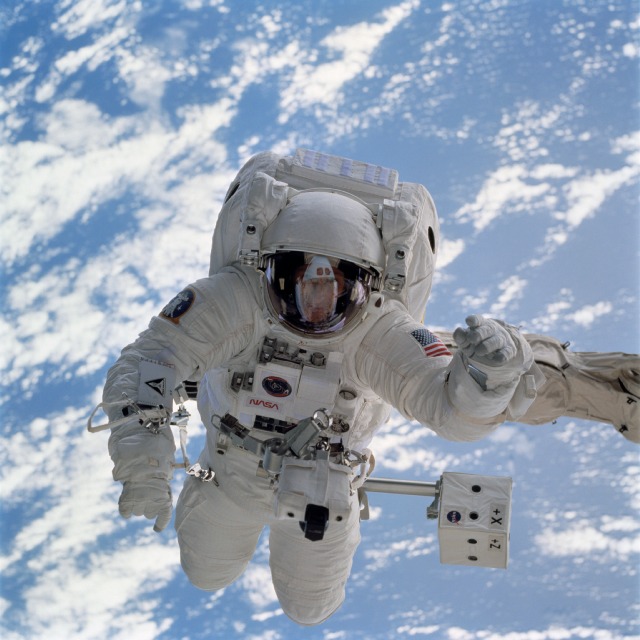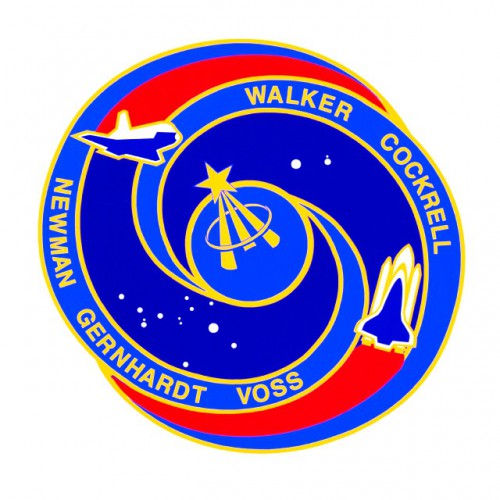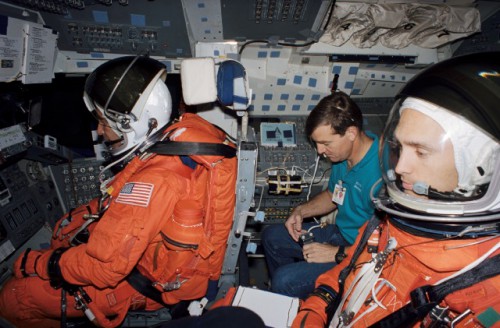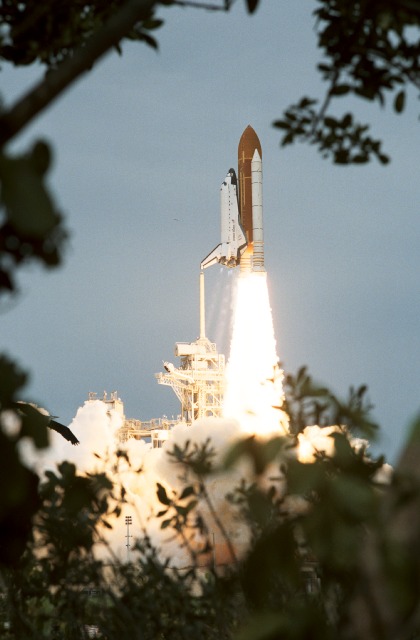
Nineteen years ago, last week, the “Dogs of War” barked, woofed, and yelped their way through a remarkable mission which put virtually all of the space shuttle capabilities—satellite deployment and retrieval, rendezvous and proximity operations, spacewalking, and science—to the test. During STS-69 in September 1995, Commander Dave Walker, Pilot Ken Cockrell, Payload Commander Jim Voss, and Mission Specialists Jim Newman and Mike Gernhardt put a series of lengthy delays behind them and successfully completed one of the most impressive and multi-faceted flights in the shuttle program’s 30-year history. Yet, less than a decade since the calamitous loss of Challenger, STS-69 illustrated that the long shadow of tragedy was never far away and vigilance in shuttle operations could never be taken for granted.
The mission was planned for launch at the end of July 1995, kicking off a complex, 11-day flight to deploy and recover a pair of satellites and perform an EVA to evaluate techniques and tools for International Space Station (ISS) construction and maintenance. However, in the days after the landing of the previous shuttle mission—STS-70 on 22 July—disassembly of its Solid Rocket Boosters (SRBs) revealed a tiny air pocket, known as a “gas path,” in the nozzle internal joint No. 3, at the base of the right-hand booster.
It extended from the motor chamber, through the Room Temperature Vulcanizing material, and up to the primary O-ring, the latter of which provided a critical sealing mechanism to prevent gas at a temperature of 2,760 degrees Celsius (5,000 degrees Fahrenheit) leaking through the booster casing. Although the primary O-ring was unbreached on STS-70, it did exhibit a “slight heat effect,” a trio of singe marks and small amounts of soot. Also observed were heat-affected insulation and eroded adhesive. As well as having been a key player in the loss of Challenger, a similar gas-path issue was noted after the STS-71 mission in June 1995. “Gas paths or small air pockets are the result of nozzle fabrication involving backfilling of the joint with insulation material,” explained NASA’s anomaly report. “Similar paths had been expected or observed following previous flights, but missions STS-71 and STS-70 marked the first time slight heat effect was noted on the primary O-ring.”

As investigators set to work on the problem, the STS-69 launch met with delay. Originally targeted for launch on 30 July, Endeavour and her crew first fell foul to the ravages of Hurricane Erin, which was threatening the coast of Central Florida. Having been initially rolled out to Pad 39A on 5 July, the shuttle stack was rolled back to the Vehicle Assembly Building (VAB) on 1 August as a protective measure and returned to the pad on the 8th. However, by this stage, as the SRB anomaly became more clear, the launch was postponed until no earlier than the end of August.
Although the primary O-ring was not breached and the secondary O-ring was untouched in the STS-71 and STS-70 ascents, it became clear that similar instances of exhaust burning through to reach the seals had occurred on 11 previous shuttle flights. Quoted by Flight International a few days later, NASA noted that there were “no design issues” with the SRBs and that the STS-71 and STS-70 crews were in “no added danger,” the investigation team was studying a procedure which could allow for ultrasound inspections and minor adjustments to the injection of an insulating putty. It was hoped that this “may reduce” the possibility of gas paths reaching the primary O-ring on future missions.
“Working inside the nozzle of the boosters,” explained Flight International on 30 August, “technicians are replacing the insulating material protecting the nozzle O-ring joints with a new material. Seven sets of [SRBs] will undergo this work and the new material will be introduced on future production.” Although it was considered unlikely that STS-69 would fly until at least mid-September 1995, engineers and managers ultimately concluded at the Flight Readiness Review (FRR) that the issue did not pose a significant safety-of-flight concern and the mission was rescheduled for launch on 31 August.
However, this attempt was scrubbed by the Mission Management Team at 3:30 a.m. EDT on the 31st, just prior to the loading of liquid oxygen and hydrogen aboard the External Tank (ET), when a temperature “spike” was recorded in Endeavour’s No. 2 fuel cell. Since mission rules dictated that all three of the orbiter’s electricity-generating cells had to be fully operational for a launch to go ahead, it was elected to replace the unit and the countdown resumed on the afternoon of 4 September, tracking a liftoff on the 7th. Early that morning, the STS-69 crew departed their quarters and arrived at Pad 39A at 8:10 a.m., with Newman taking a moment on the gantry to snap a photograph of his four crewmates. They took their seats aboard the shuttle, but after closing and sealing the middeck side hatch it failed to pass a standard leak check. The hatch was reopened, its seals checked, and it was closed and retested without incident. Later in the countdown, a pressure issue cropped up with a water spray boiler, but was cleared, since it did not violate any Launch Commit Criteria and posed no constraints. In the final minutes, Walker stretched out his gloved hand to his three comrades on the flight deck—Cockrell, Voss, and Newman—to express how much he had enjoyed training with them. Endeavour thundered safely into orbit at 11:09 a.m. EDT.
For the first time in the shuttle program, two satellites would be deployed and retrieved, using the Canadian-built Remote Manipulator System (RMS) mechanical arm on STS-69. The first was the Wake Shield Facility (WSF), flying its second mission, and the other was the Shuttle-Pointed Autonomous Research Tool for Astronomy (SPARTAN)-201. Yet when veteran NASA astronaut Jim Voss was assigned as Payload Commander of STS-69 in August 1993, the cargo was quite different, consisting instead of the fourth Spacehab laboratory and the Shuttle Pallet Satellite (SPAS)-III.

“Spacehab is a complement of commercial experiments flown in a pressurized module in the shuttle’s cargo bay as a supplement to the middeck of the orbiter,” a NASA press release announced, “and SPAS-III is a group of instruments which will measure the atmosphere around the orbiter and the background clutter in the Earth’s atmosphere, calling for a complex flight plan.” One of the key instruments aboard SPAS-III was the Infrared Background Signature Survey (IBSS), developed by the Strategic Defense Initiative (SDI). Distinguished by its large, barrel-shaped cryostat, IBSS had previously flown on the STS-39 mission in April 1991 and sought to obtain scientific data in support of missile defence applications. Flying freely from the shuttle aboard SPAS-III at various ranges, IBSS would make spectral, spatial, and temporal radiometric observations of the orbiter’s exhaust plumes and replications of booster firings. Interactions of these plumes with the ionosphere would be analysed, as would the region around the engine nozzles.
In September 1991, Flight International reported that Fairchild Space had been awarded a $14 million systems integration contract for SPAS-III by the SDI’s Sensor Technology Directorate. However, SPAS-III and IBSS met with delay and eventually cancellation, and by the time the remainder of the STS-69 crew was named in July 1994 it had vanished from the payload complement entirely. So too had the Spacehab module, which was remanifested onto a later mission. In their place was WSF-2 and SPARTAN, the latter equipped with a battery of experiments for NASA’s Office of Aeronautics and Space Technology, and known as “OAST-Flyer.” As the months wore on, OAST-Flyer was itself shifted onto a subsequent flight and replaced with the SPARTAN-201 payload, equipped with two instruments for solar science research. As payload commander, it was Voss’ responsibility to develop and co-ordinate the crew’s training plan, liaise with the mission’s payload sponsors and principal investigators, attend relevant meetings, and oversee pertinent hardware and software changes, ahead of the announcement of the other crew members.
Voss and Dave Walker had previously flown together on STS-53. During preparations for that mission, their training instructors nicknamed them “The Dogs of War” and the entire team received individual “dog names” and “dog tags.” In recognition of his hair, Walker became “Red Dog” and Voss assumed the moniker of “Dog Face”; for STS-69, they continued the tradition and their fellow crewmates acquired their own alter-egos: Ken Cockrell became “Cujo,” Jim Newman became “Pluto,” and Mike Gernhardt—the only rookie astronaut—became “Underdog.” On launch morning, 7 September 1995, Walker and his men presided not over plates and mugs and cutlery at the breakfast table, but over a quintet of dog bowls, each emblazoned with their respective dog names. As they departed crew quarters, they were greeted by a chorus of tongue-in-cheek barks and woofs from the assembled journalists, family members, and friends. Even in orbit, the astronauts could not escape: on the morning of 10 September, three days into the mission, they were awakened to the sound of “Bingo Was His Name,” sung by Cockrell’s five-year-old daughter, Madeline. …

When STS-69 launched, Newman was the only member of the crew to boast a spacewalk to his credit. That was expected to change, for NASA had implemented a series of EVA Development Flight Tests (EDFT) to evaluate tools and techniques for the construction of the ISS. Already, on STS-64 in September 1994 and on STS-63 in February 1995, shuttle spacewalkers had evaluated a variety of new systems, and on STS-69 Voss and Gernhardt would perform a 6.5-hour spacewalk to press the envelope still further. Planned for late in the 11-day mission, the excursion would support four Detailed Test Objectives (DTOs): to evaluate space suit design modifications to guard against extremely cold temperatures, to perform specific assembly and maintenance tasks, to evaluate an Electronic Cuff Checklist, and to support ground crews in making improvements to EVA operations. Specifically, it was intended that Voss and Gernhardt would perform an hour apiece at a “task board” on the starboard side of Endeavour’s payload bay, working with hand rails, mechanical fasteners, electrical and fluid connectors, and mock-up Orbital Replacement Units (ORUs). The men would also install a pair of “thermal cubes” in the payload bay—one at the end of the RMS mechanical arm, the other at the task board work site—to gather temperature data. Additional measurements would be taken from sensors inside their space suits throughout the EVA. To differentiate between the two men, Voss was designated “EV1” and wore red stripes on the legs of his suit, whilst Gernhardt (“EV2”) wore a pure-white suit.
Near the end of STS-69, on 16 September 1995, Voss and Gernhardt prepared for the first spacewalk of their respective careers. At length, a go-ahead came from Mission Control and Voss commenced the final depressurization of the airlock and pushed open the outer hatch into the payload bay. Sunlight flooded into both of their faces and, beyond, the enormous expanse of the bay. The EVA officially started at 4:20 a.m. EDT, and the spacewalkers’ first task was to install the thermal cubes at the end of the RMS and at the task board on the starboard wall of the bay. They then removed a debris shield from the work site, manipulated a duplicate of a computer control box for ISS hardware, and tested new helmet lights and suit heaters. Taking turns at the end of the RMS, they were maneuvered by Newman away from the radiated warmth of the payload bay, exposed to temperatures as low as -84 degrees Celsius (-119 degrees Fahrenheit).
Earlier in 1995, STS-63 spacewalkers Mike Foale and Bernard Harris had ended their EVA early when suit modifications to counter cold temperatures proved ineffective. However, on STS-69, Voss and Gernhardt benefited from battery-powered fingertip heaters in their gloves and a system which enabled them to totally shut down their suits’ liquid-cooling system and rely upon body heat for warmth. The men continually provided subjective ratings on their comfort levels to flight controllers and experienced no difficulties during their “cold soak” evaluations. They returned inside Endeavour after an EVA lasting six hours and 46 minutes. Yet Voss and Gernhardt’s spacewalk was but a relatively minor component of STS-69, which became the first shuttle flight to launch and retrieve two satellites during the same mission.
The second part of this article will appear tomorrow.
Want to keep up-to-date with all things space? Be sure to “Like” AmericaSpace on Facebook and follow us on Twitter: @AmericaSpace




As I remember, the dog-crew names began on STS-53, the last classified DoD flight on Shuttle. Dave Walker was the commander and I was the Lead Flight Director. To go along with the dog names of the crew, the USAF General dubbed Dog Meat”, because that was what would happen to be if I messed up that mission. Great times!!!! Lived Bering part of the dog-crew mission on 53!